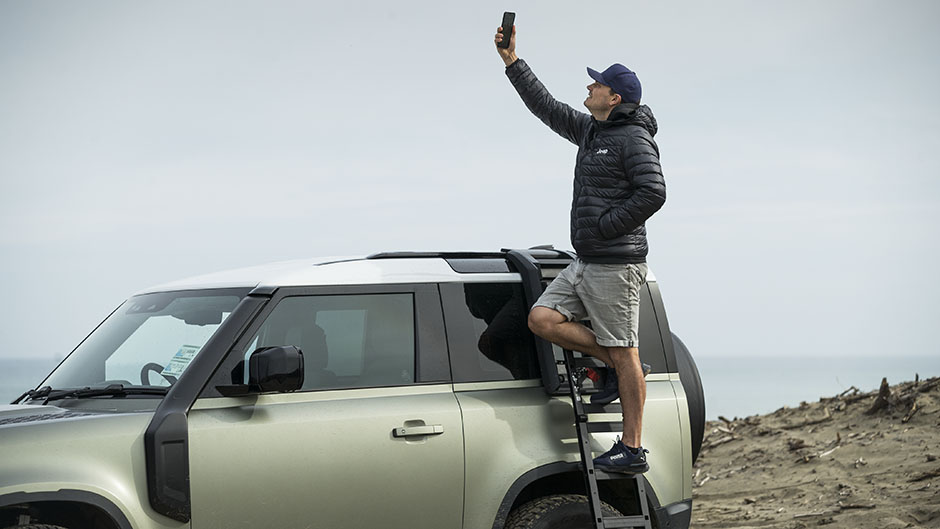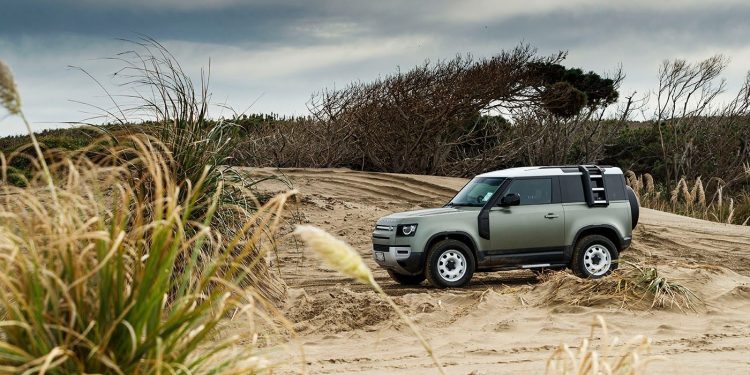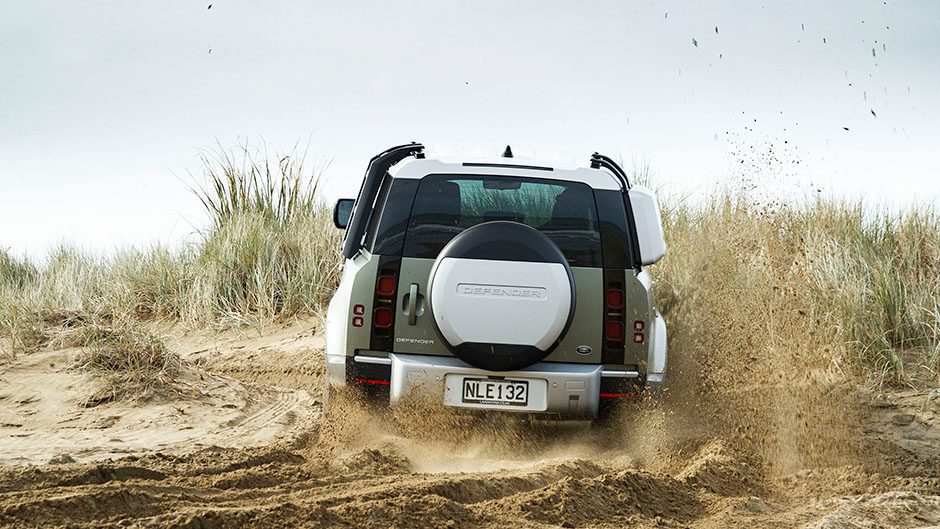2021 Land Rover Defender 90 S review
Words Kyle Cassidy | Photos Tom Gasnier
The short wheelbase Defender, aka the 90, has arrived. Is it the bee’s knees?
Land Rover revealed both the 90 and 110 versions of the re-born Defender simultaneously, though production of the shortie was scheduled to start a few months after the 110 started rolling into showrooms. And then Covid hit and the factory in Slovakia was forced to pause, causing a backlog of 110 orders and further delays for the 90. So a year after the five-door landed, the cheeky three-door has started to arrive, albeit in severely constrained numbers. We were lucky to snatch a drive.
The 90 is simply a shortened version of the five-door 110. It sits on the same D7x aluminium monocoque with its independent suspenders all round. It has the same ‘twin-speed’ auto (a ZF eight-speed with a low range), the auto centre differential (opening and locking depending on the situation) and the Terrain Response system to help the Defender eat up that which lays ahead (sand, snow, rocks, whatever).
The 90 is 435mm shorter in length, all of that removed from the wheelbase. It otherwise possesses the same abbreviated overhangs, approach and departure angles (38 and 40 degrees respectively) though it has a slightly better breakover angle (25 deg vs 22). It’s rated to tow the same 3500kg too, but whether people are that keen to haul with a short wheelbase rig is another thing.

Also equivalent are the 291mm of ground clearance, 500mm of articulation and 900mm wading depth. So the 90 is ridiculously capable off-road, just like big brother, ’cept being shorter, it’s even more so. Being slightly smaller just helps off road, for it can wriggle around in tighter going more easily. About the only thing we noticed was the additional jiggling over rough terrain, the shorter wheelbase unable to dissipate the warp and pitch as well. The particular 90 we were wrangling rode on standard coil springs, missing out on the spongy nature of the air sprung 110s we have driven. Still, it has the same 4×4 hardware and trick software that controls it all, making it damn easy to conquer the badlands. The off-road aids are rather adept at controlling the torque at each wheel so it can inch up and over obstacles with ease. And in the Terrain Response’s sand mode, it makes a handy dune buggy.
So, it’s still a marvel off road but, like the 110, it’s the on-road demeanor that has changed most markedly from the ‘real’ Defenders of times past. Being shorter between the axles, there’s a tad more urgency on the turn than the 110. We wouldn’t call it nimble but the 90 is more interested in changing directions than the long version. On the flip side, it’s not as stable through longer bends, and you find yourself making a few more mid-corner steering adjustments as a result. The all-terrain tyres hang on okay, on a dry road that is, and there is at least some feel to the steering. But there’s also some roll and tyre squish as it turns in. Like the 110, it’s ultimately reliant on the stability aids nipping the brakes to help it stay the course when pressed. But that’s because it’s still a hefty wee thing at 2300kg. Despite its shorter wheelbase and those coil springs, this rides well on both city and country paths, possibly helped by the proper 4×4 wheel and tyre package.
The 90 S, which we drove, is only available with the entry-level D200 147kW four-pot diesel. With twin turbos, it makes a reasonable 430Nm, and it combines okay with the auto. You’ll want to neuter the stop/start as that amplifies hesitation of the mark. Occasionally the oiler gets caught off boost while sometimes the trans changes up a tad early, but there is generally good pull around the 1500rpm mark. It does however feel stronger once the needle swings past 2000rpm. Selecting the auto’s Sport mode helps the trans make a better fist of the outputs when you’re in a hurry. The diesel is pretty quiet, with minimal clattering while fuel use you can expect to even out between 9-10L/100km.

The 90 S D200 retails for $103,900 before the spend up on options. It’s the cheapest of the eight 90 variants, the P400 X topping out at $164,900. It makes the entry point for the 90 range slightly higher than for the 110, however. Where the variants line up on spec, the 110 is around $9k dearer.
The three-door SUV genre isn’t as popular as it used to be, and is such a thing ever really practical? That will depend on your ‘lifestyle’ and how often you’ll use the back seat. Entry to the rear is relatively easy, compared with most low slung coupes that is. The front seats are only partially powered, the electrics adjusting the recline whereas the squab movements are all manual. That’s a good thing as it’s painful waiting for a powered seat to motor its way slowly forward before it grants passage to the back. Given the added cabin height of an SUV, it’s easy then to climb on board. And there’s good space back there too, with enough leg room, and three abreast isn’t much of a squish.
The boot space is measly however, failing to hold the weekly grocery shop. The rear seats flop over but don’t form a flat load space. And then there’s the side-hinged tailgate, all part of the Land Rover DNA and all, but also heavy and impractical in most car parks. Kind of like the front doors, especially for little people to manage.

When the Defender was greenlit for revival, a few key elements were considered essential including the ‘distinctive silhouette’, that side-hinged rear door and a centre front jump seat. The latter was said to be ‘conceived and designed as an occasional seat’ which hints at its usefulness. The $1550 option turns the 90 into a six-seater and our primary-aged kids loved perching there, just because it’s something a bit different. And it’s these types it’s made for; you wouldn’t want a front rower in there next to you. When folded, it provides a front armrest and a pair of cupholders, which get filled with what-have-you as decent storage is otherwise lacking.
If you option the dickie seat, you really need to tick the box for the clear sight rear view camera ($1150) as well, which projects an unobstructed view of the traffic behind to the rear view mirror. The outlook is obstructed by both the spare wheel on the door and the rear seat but it’s completely obscured with the jump seat in place.
The 90 has myriad other (standard fit) cameras to help progress. The off-road function shows where the front wheels are tracking and this is quite handy in the concrete jungle when you’re trying to manoeuvre this rather wide machine (just over 2m) into a tight spot. Is the 90 easier to park than the 110? Certainly, it has a better turning circle (11.3m vs 12.84m) nipping around more easily than most genuine 4x4s can. The steering is light, and aside from the oversized steering wheel, obligatory in a Land Rover, there are only 2.7 turns between locks.

Despite the ‘command driving position’, your forward vision can be restricted by the chunky A pillars and big side mirrors, meaning some intersections require a second look. And rearwards vision is further fouled by the various strap-on accessories this wears on its flanks which fill the side mirrors. These marketing department add ons should be optioned with caution. The side mounted gear carrier is of questionable use – it’s about as big as a lunch box as someone put it – and most sniggered at the ladder to nowhere. The white steel wheels receive a more favourable reception, so too the contrast coloured roof (a $2000 option). This 90 also wears a paint protection layer, a factory fitted polyurethane wrap that forms a guard against annoying scratches inflicted off the beaten trail or in the car park. Some will deem this extra worth the $7800 for the ‘on trend look’ alone, giving the metallic paint a satin finish.
The Defender’s interior they label ‘reductionist, purposeful, functional, durable’. Despite the descriptive hyperbole, we quite like it’s posh ruggedness, especially the rubber flooring and flush door sills so you can brush out the muck of your active lifestyle. You can option in some plush carpet mats if you want, but really?
An infusion of tech comes via the digi dials, and the infotainment screen sits snugly in the exposed cross beam that shores the chassis up and forms the dash. The screen has a wide but slim format, limiting the view on some functions, but it’s quick to respond, vibrant and logical to use.
With these must-have SUVs, you know some will buy it merely to ponce about in the latest ‘icon’. It’s more of a statement than a tool to get things done. If you buy one, you need to take it off road to enjoy it fully. But in the meantime, enjoy the envious stares.
| Model | Land Rover Defender 90 S |
| Price | $103,990 |
| Engine | 1999cc, IL4, TDI, 147kW/430Nm |
| Drivetrain | 8-speed auto, all-wheel drive |
| Fuel Use | 7.5L/100km |
| C02 Output | 199g/km |
| 0-100km/h | 9.98sec |
| Weight | 2318kg |
















